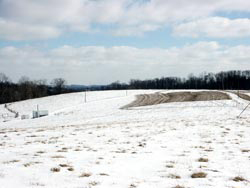Winter Manure
National Agriculture Information
- Agriculture
- Basic Information
- Where You Live
- Frequent Questions
- Sectors
- A to Z Subject Index
- Air
- Business Assistance
- Health & Safety
- Pesticides
- Site & Equipment
- Sustainability
- Water
- Laws & Regulations
- Resources
Agricultural Research Service, EPA Partner Up to Protect Watersheds
April 2007
This winter, scientists in the U.S. Department of Agriculture Agricultural Research Service's (ARS) North Appalachian Experimental Watershed Unit (NAEW) at Coshocton, Ohio, applied various animal manures to check water quality effects. They want to know whether leaving land near the edges of fields manure-free will ensure that winter manure applications are environmentally sound.
US EPA is collaborating in these studies, as part of its efforts to partner with agricultural scientists for the benefit of farmers and the environment. EPA is concerned about water pollution from manure runoff over frozen soil.
ARS hydrologist James V. Bonta and soil scientists Lloyd B. Owens and Martin J. Shipitalo supervised the application of liquid swine manure and turkey litter manure to cornfields on four small watersheds, and of beef cattle manure slurry to four grass plots. Surface runoff is collected by Coshocton Wheel samplers to be analyzed for quality and to determine volume. Runoff volumes are measured at the watersheds using flumes. ARS scientists analyze water for nitrogen and phosphorus, as well as oxygen depletion.
NAEW researchers have been testing runoff for many years. EPA partially funds this new study, supporting ARS technician Jim Buxton—who does the water sampling—and paying for supplies and training. Buxton sends samples to the EPA Research and Development Office in Cincinnati, Ohio. There, microbiologist John Haines and environmental engineer Shane Rogers analyze samples for E. coli and enterococci pathogens. Enterocci bacteria have replaced fecal coliform bacteria as indicators of the likely presence of other pathogens in water that can also infect people.
The ARS-EPA partnership gives the Coshocton lab funding support and the capability to monitor pathogens, while EPA gains a site ready-made for the study—complete with instruments already in place and researchers with decades of experience in testing for runoff nutrients. The goal is to find a way to avoid the costs farmers now incur from storing manure over winter, while keeping environmental impacts at a minimum.
ARS is the U.S. Department of Agriculture's chief scientific research agency.

Researchers applied liquid swine manure to part of this hillside (the area without snow cover) near Coshocton, Ohio. Runoff will collect downhill in the sampling shed at left, so it can later be analyzed for sediment, nutrients and pathogens. EPA and ARS scientists want to find out if the snow-covered buffer area downslope of the area receiving manure can reduce pollution from manure runoff on frozen ground. Photo courtesy of Martin Shipitalo, USDA/ARS.
Additional Information
- Manure Plot Research Design
- "The Quality Assurance Plan for Winter Runoff of Surface Applied Animal Manure and Process Wastewater" (PDF) (61pp., 2.2MB) is the scientific/technical document that describes the project in detail, including project design and objectives, sampling and testing protocols and procedures, proposed data analysis, and measures taken to ensure the scientific validity of all data collected and analysed for this research project.
- Map of the study area near Coshocton, Ohio

Contacts
EPA-USDA/ARS Research Partnership Contacts
- EPA Region 5 CAFO Expert Steve Jann (jann.steve@epa.gov)
- EPA Region 5 Agriculture Advisor Thomas Davenport (davenport.thomas@epa.gov)
Scientific Contacts
- James V. Bonta (jim.bonta@ars.usda.gov)
- Lloyd Owens (lloyd.owens@ars.usda.gov)
- Martin Shipitalo (martin.shipitalo@ars.usda.gov)
![[logo] US EPA](../gif/logo_epaseal.gif)